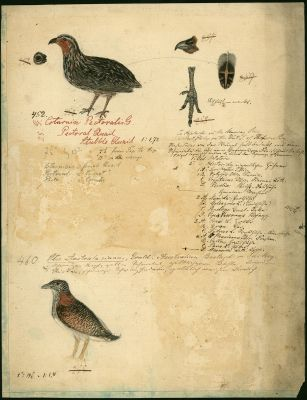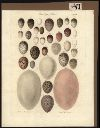› Historische Arbeitsstelle am Museum für Naturkunde
Handzeichnung, Coturnix pectoralis u.a.
Darstellung einer Schwarzbauchwachtel (Cotornix pectoralis, Gould 1837), seitlich nach links, mit Detailstudien des Schnabels, einer Klaue und einer Feder, beziffert mit der Zahl 452, sowie eines Fragment gebliebenen, als "Australian Bustard" bezeichneten Vogels, ebenfalls seitlich nach links, beziffert mit der Zahl 460. Vorlagezeichnungen für Gustav Mützels "Birds of Australia, Plate 103" und "Plate 104". Nr. 452 auf Plate 103 ist als Coturnix pectoralis zu identifizieren, unter Nr. 460 auf Plate 104 ist die Spezie Ardeotis australis (Australien Bustard) dargestllt, die keinerlei Ähnlichkeit mit der Vogelstudie 460 auf diesem Blatt aufweist.

Detailangaben
| Eintragstyp | Bilddokumente |
|---|---|
| ID | 16030 |
| Inventar-Nr. | Nachlass Blandowski Bestand: Zool. Mus. Berlin Signatur: BVIII/317 |
| Sachtitel | Coturnix pectoralis und ... |
| Hersteller | Wilhelm von Blandowski |
| Beschriftung | a) 452. Coturnix Pectoralis. G. / Pectoral Quail / Stubble Quail 1:1,73 / 71/2 frpm Tip to tip / 13 in the whings. / Coturnicis = femail Quail / pectoral = Breast? / Pecto = Comb [hss. mit schwarzer und rotbrauner Tinte und Bleistift] b) Sitzfuß - nackt. / In Adelaide on the Murray Riv. / In Port Philip on the West S. of. Hopsons [?] Bay. / Nasenlöcher an der Wurzel halb bedeckt mit einer / Schwiele die aus einer knorpeligen Fleischhaut besteht. / Flügel legen sich neben u. unter dem Schwanze zusammen. / 1. Ord. natatores / 2. Ord. Alectorides eigentliche Hühner / 1. A: Syrrhaptes Tllig. [?] / 1. B Ortygis Tllig. [?] Turnix. / C. Crypturus Tllig. [?] Tinamus Lath. / D. Pendix Brihs. [?] Feldhuhn / [zwei Wörter unleserlich] / 2 A. Numida (Perlhuhn) / B. Meleagris L. (Truthuhn) / C. Penelope Gmel. Taku / D. Opisthocamus Hofnegg. / 3. A. Crax L. Hokke [?] / B. Urase Cuv. / C. Tetras L. Waldhuhn - [unleserlich - ]hahn / 4. A. Phasianus Tllig. Fasan. / B. Gallus Haushuhn / C. Pavo L. Pfau. / D. Maenuna Lath. Lyre. [hss. mit schwarzer Tinte] c) 460. Otis Australianus, Gould. Australian Bustard - Turkey / schwarzer Kopf, gelber Schnabel, gelblichgrün Kehle, brauner Rücken, schwarze Schwanzfedern, gelblich weißer Bauch. [hss. mit Bleistift und brauner Tinte] d) 8" : 14 1/2" = 1:1,81 [hss. mit schwarzer Tinte] e) Quail amidst low bushes near the coast, they rise from unter the feet, with starting suddenness and bustle and not seltem perplexed the sportsman. I saw them solitary or in pairs. The skin is verry easy obtained an[d] the flesh is white and exellent. // The eggs ar[e] 4 and white with brown spots, only few leaves on the ground forms the nest.- Flapping with the whings when rose nearly like a pigeon. // I believe the quails are very indolent birds, they usually sleep through great part of the day, concealed among the high grass, lying on their sides, with their legs extended (j)ust like [folgt unleserliches Wort] when the[y] take a sandbad. and this is i believe mor[e] the cause why man approach them so easy. // The males are birds of great courage and their quarels frequently terminate in mutual destruction. Quail fighting was practised by the Greeks and Romans. [hss. mit schwarzer Tinte] f) 452 auf Pl. 103 / 460 auf Pl. 104 [hss. mit Bleisrtift] g) Bestand: Zool. Mus. Berlin / Signatur: BVIII/317 / Inv.Nr. A - [Stempel und hss. mit Kugelschreiber] |
| Beschriftungsort | a) Blatt l. (unter der Darstellung des Coturnix pectoralis) b) Blatt r. [unter den Teilstudien] c) Blatt u. M. d) Blatt u.l. e) Blatt Rückseite o. f) Blattrückseite u. g) Blattrückseite u. |
| Format | 32 x 24,7 |
Verschlagwortung
- Allgemein: › Fachgebiet › Biologie › Ornithologie
- Fachgebiet: › Fachgebiet › Biologie › Ornithologie
- Allgemein: › Fachgebiet › Biologie › Zoologie
- Allgemein: › Fachgebiet › Kunstgeschichte
- Allgemein: › Forschungsthema › Bildgattung › Objektdarstellung, wissenschaftlich
- Gattung: › Forschungsthema › Bildgattung › Objektdarstellung, wissenschaftlich
- Allgemein: › Forschungsthema › Ikonographie › Naturstudie › Tierstudie
- Allgemein: › Körperschaft › Museum für Naturkunde - Leibniz-Institut für Evolutions- und Biodiversitätsforschung
- Allgemein: › Lebewesen › Tier › Chordata › Vertebrata › Aves › Galliformes › Phasianidae › Coturnix pectoralis
- Darstellungsinhalt: › Lebewesen › Tier › Chordata › Vertebrata › Aves › Galliformes › Phasianidae › Coturnix pectoralis
- Allgemein: › Material › Papier
- Material: › Material › Papier
- Allgemein: › Ort › Weltregion/ Meer › Australien (Kontinent)
- Allgemein: › Person › Namen A-Z › Blandowski, Wilhelm von
- Form: › Repro/ Medium › 2D-Scan
- Allgemein: › Sammlung › Historische Bild- und Schriftgutsammlungen des Museums für Naturkunde
- Allgemein: › Sammlungsobjekt › Provenienz › Nachlass Wilhelm von Blandowski
- Allgemein: › Sammlungsobjekt › Zweidimensionales Objekt › Bilddokument › Zeichnung › Handzeichnung
- Dokument-Typ: › Sammlungsobjekt › Zweidimensionales Objekt › Bilddokument › Zeichnung › Handzeichnung
- Allgemein: › Technik › Maltechnik › Aquarell
- Technik: › Technik › Maltechnik › Aquarell
- Allgemein: › Zeitraum › Jahr › 19. Jh.



